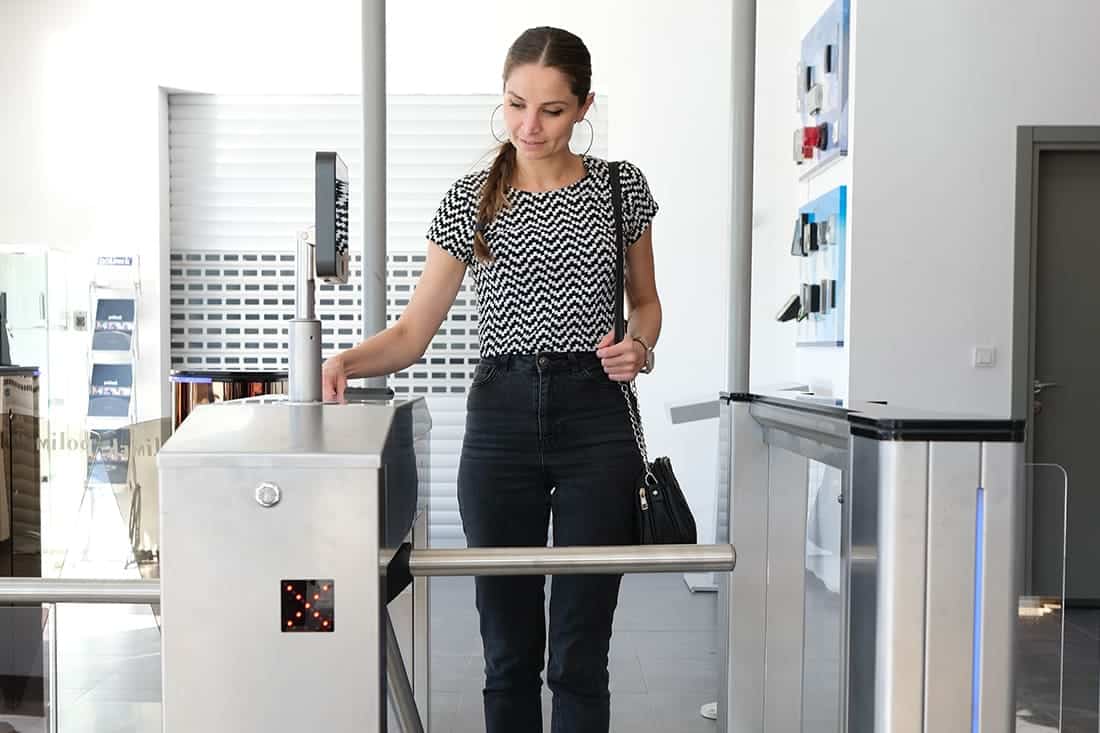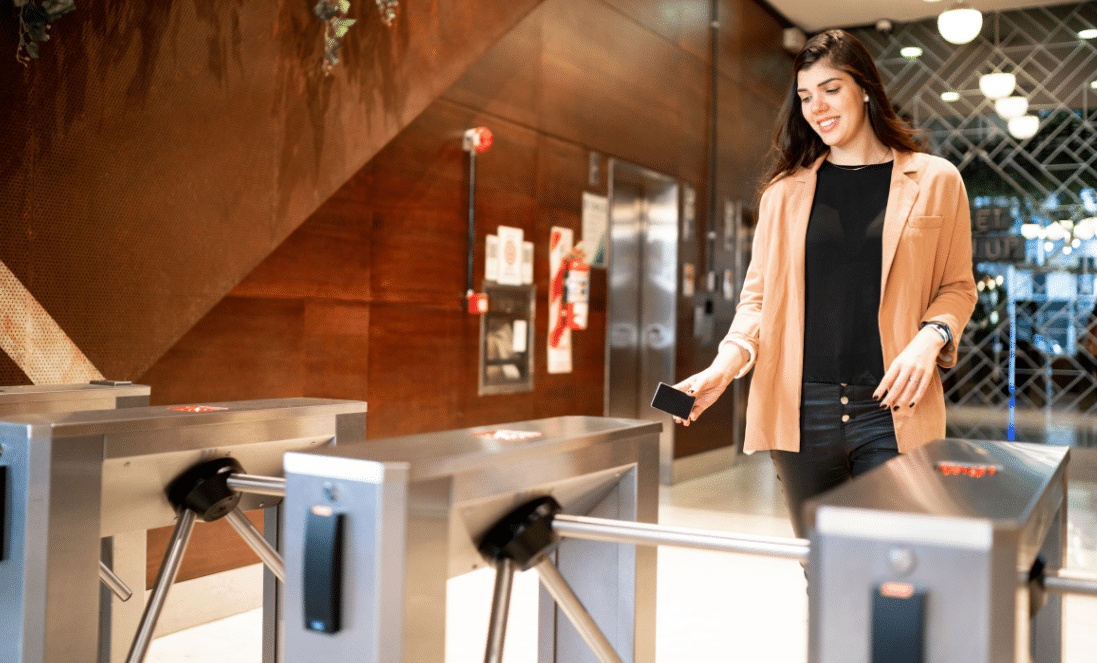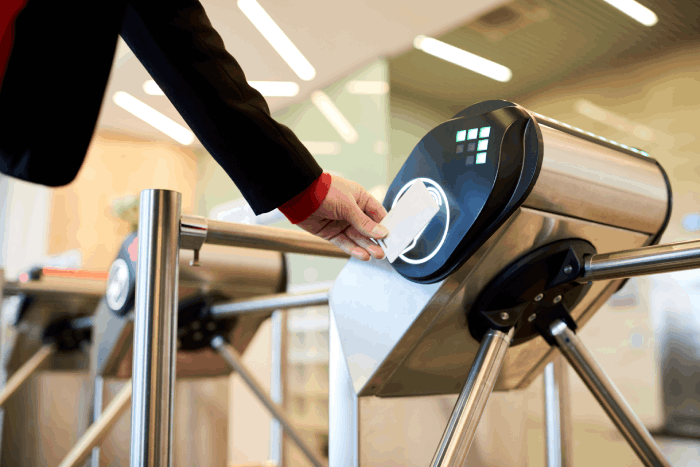- Home
- About Us
- Products
- Electronic Article Surveillance System EAS / Retail Anti theft Systems
- Display Stands
- Restaurant Pager
- People Counting Systems
- Queue Management Systems
- Access Control System
- Time Attendance Systems
- Audio & Visual System Solutions
- Display Solutions
- CCTV Cameras in Qatar: Enhancing Security Solutions
- Time Lapse Construction Camera
- Flap Barrier, Speed Gates, Turnstiles Access Control
- Gate Barriers System & Bollards in Qatar
- Parking Management & Gate Automation
- Library Management Systems
- IT & Telecom
- Lockers & Key Management Systems
- Intrusion Alarm System
- Perimeter Security
- Vehicle Tracking
- Time Recorders & Time Stamps
- Emergency Exit Door Alarms
- Clients
- Contact Us
- Support
Contents
Turnstile Access Control: Streamlined Security and Efficient Entry
What Are Turnstile Access Control Systems?
Turnstile access control refers to using turnstiles and gates to regulate entry into or exit from a specific area. These systems play a crucial role in enhancing security by ensuring that only authorized individuals gain access. Whether it’s a busy stadium, a mass transit station, or an office lobby, turnstiles provide a seamless and convenient experience while maintaining strict control over entry points.
How Do Turnstile Access Control Systems Work?
Turnstiles operate on a simple yet effective principle: one-at-a-time entry. Unlike regular doors, where multiple people can pass through simultaneously, turnstiles allow only one person at a time. Here’s how they work:
Credential Authentication: Individuals must present proper credentials (such as a pass, keycard, or fob) to unlock the turnstile. Without valid credentials, the turnstile remains locked.
One-Way Movement: Once authenticated, the turnstile allows entry in a single direction (usually forward). This prevents unauthorized individuals from tailgating or piggybacking.
Exit Control: Turnstiles can also be configured for exit control. In this case, individuals must present their credentials to exit the secured area.
Different Models of Turnstile Access Control
1. Waist-High Tripod Turnstiles:
These turnstiles are commonly used in office buildings, gyms, and public facilities.
They have three rotating arms and allow bi-directional access.
Ideal for areas with moderate traffic.
2. Full-Height Turnstiles:
These robust turnstiles provide enhanced security.
Available in various widths to accommodate wheelchair access.
Commonly used in stadiums, industrial sites, and high-security zones.
3. Optical Turnstiles:
Sleek and modern, optical turnstiles use infrared sensors.
Ideal for upscale lobbies, corporate offices, and museums.
Bi-directional and space-efficient.
Best Practices for Turnstile Access Control
Placement: Install turnstiles at strategic entry points, considering foot traffic flow and security requirements.
Integration: Integrate turnstiles with existing access control systems for seamless management.
Credential Management: Regularly update and manage user credentials to maintain security.
Visitor Access: Set up a separate lane for visitors to streamline their entry process.
Choosing the right turnstile for your business involves considering several factors to ensure it aligns with your specific needs. Let’s break down the decision-making process:
Purpose and Location:
Identify the Purpose: Determine why you need a turnstile. Is it for crowd control, security, or both? Consider whether it’s for indoor or outdoor use.
Location: Assess where the turnstile will be installed. Is it at the entrance of an office building, a stadium, a factory, or a transportation hub?
Traffic Flow and Capacity:
Traffic Volume: Evaluate the expected foot traffic. High-traffic areas (such as airports) require robust turnstiles, while low-traffic areas (small offices) can opt for simpler models.
Capacity: Choose a turnstile that can handle the anticipated flow without causing bottlenecks.
Type of Turnstile:
Waist-High Tripod Turnstiles: These are versatile and suitable for moderate traffic. They have three rotating arms and allow bi-directional access.
Full-Height Turnstiles: Ideal for high-security zones, stadiums, and industrial sites. They provide enhanced security and can accommodate wheelchair access.
Optical Turnstiles: Sleek and modern, these use infrared sensors. Perfect for upscale lobbies and corporate offices.
Integration with Access Control Systems:
Ensure the turnstile integrates seamlessly with your existing access control system. This includes card readers, biometric scanners, and visitor management software.
Durability and Maintenance:
Materials: Consider the turnstile’s construction materials (stainless steel, aluminum, etc.). Durability matters, especially for outdoor installations.
Ease of Maintenance: Opt for turnstiles with minimal moving parts and easy-to-replace components.
Security Features:
Anti-Tailgating: Look for turnstiles with anti-tailgating technology to prevent unauthorized entry.
Emergency Release: Check if the turnstile has emergency release mechanisms for evacuation during crises.
Aesthetics and Space Constraints:
Aesthetics: Choose a design that complements your space. Optical turnstiles, for instance, offer a sleek appearance.
Space: Consider the available space. Full-height turnstiles require more vertical clearance.
Budget:
Determine your budget. While turnstile security is essential, find a balance between features and cost.
Remember, each business has unique requirements. Consulting with a turnstile expert or a reputable supplier like Axle Systems can help you make an informed decision. They can guide you on the best fit for your business in Qatar. Feel free to reach out to them for personalized assistance!
Turnstile access control systems offer several benefits for businesses and organizations. Let’s explore these advantages:
Enhanced Security:
Turnstiles allow only authorized personnel to enter, acting as a tough barrier against unauthorized entrants.
Full-height turnstiles, with their floor-to-ceiling construction, provide virtually impenetrable security for high-risk areas like data centers, prisons, and government facilities.
Visual Deterrent:
Turnstiles, especially full-height ones, serve as a visual deterrent. Their large steel construction discourages potential threats before they even attempt unauthorized entry.
Efficient Traffic Management:
Turnstiles regulate pedestrian flow, preventing overcrowding and ensuring smooth movement.
Counters in turnstiles help measure foot traffic, identify peak times, and optimize operations.
Payment Enforcement:
Venues requiring payment upon entry (such as amusement parks or public transportation terminals) benefit from turnstiles.
Turnstiles enforce authorized entry autonomously by scanning tickets or credentials.
Customizable and Adaptable:
Turnstiles come in various models (waist-high tripod, full-height, optical) to suit different facility needs.
Integration with other security systems is possible, enhancing overall access control.
Cost-Effective:
Turnstiles provide secure access control while keeping costs low.
They are durable, reliable, and easy to maintain, making them a great investment for organizations.
In summary, turnstile access control systems enhance security, streamline traffic, and contribute to efficient facility management. Consider implementing them to reap these benefits!
Turnstile access control systems come in various types, each designed to cater to specific needs. Let’s explore the most common ones:
Waist-High Turnstiles:
These fixed models stand at approximately 40 inches high.
They typically feature a central post and three rotating arms or other barrier types.
Waist-high turnstiles are commonly used for controlled access in office buildings, gyms, and public facilities.
Full-Height Turnstiles:
As the name suggests, full-height turnstiles are much larger barriers.
They operate similarly to revolving doors, allowing only one person at a time to pass through.
Full-height turnstiles provide enhanced security and are often used in high-risk areas such as data centers, prisons, and government facilities.
Optical Turnstiles:
Optical turnstiles use infrared sensors and optical barriers.
They offer a sleek and modern design, making them suitable for upscale lobbies, corporate offices, and museums.
These turnstiles allow bi-directional access while maintaining security.
ADA Gates:
ADA gates are designed to comply with the Americans with Disabilities Act (ADA) requirements.
They provide accessible entry for individuals with disabilities, including those using wheelchairs or mobility aids.
Portable Turnstile Gates:
Portable turnstiles are versatile and can be moved to different locations as needed.
They are useful for temporary events, construction sites, or areas with changing access requirements.
Remember that the choice of turnstile depends on factors such as security level, traffic volume, aesthetics, and integration with other access control systems. Consulting with experts can help you select the right turnstile solution for your specific business needs!
Types of access controls suitable for turnstiles?
Turnstiles are an essential component of access control systems, ensuring secure and efficient entry. Let’s explore the different types of access controls suitable for turnstiles:
Card-Based Access Control:
Proximity Cards: Users present proximity cards (RFID cards) to the turnstile reader. The turnstile grants access if the card is valid.
Smart Cards: These cards store additional information and can be used for multiple purposes (access, payments, etc.).
Keypad Access Control:
Users input a PIN or code on a keypad to gain access through the turnstile.
Keypads are commonly used in conjunction with other authentication methods.
Biometric Access Systems:
Fingerprint Readers: Users place their finger on a sensor for identification.
Retina Scans: Scanning the unique patterns in the retina.
Facial Recognition: Analyzing facial features for access.
Ticket-Based Access:
Common in public transportation or entertainment venues.
Users present valid tickets (printed or digital) to enter through the turnstile.
Mobile Access Control:
Users use mobile apps or digital wallets (e.g., QR codes) for entry.
Convenient and contactless.
Time-Based Access:
Turnstiles can restrict access based on time (e.g., office hours).
Useful for managing employee schedules.
Visitor Management Systems:
Turnstiles integrated with visitor management software.
Visitors receive temporary credentials for controlled access.
Integration with Other Systems:
CCTV Cameras: Monitor turnstile activity.
Alarm Systems: Triggered if unauthorized access occurs.
Intercoms: Communicate with security personnel.
Remember, the choice of access control depends on your specific security requirements, traffic volume, and facility type. Consult with experts to design a robust turnstile access control system tailored to your needs!
Common FAQ about Turnstile Access Control
What is Turnstile Access Control?
Turnstile Access Control refers to using turnstiles and gates to regulate entry into or exit from a specific area. These systems enhance security by ensuring that only authorized individuals gain access.
How do Turnstile Access Control Systems work?
Turnstiles operate on a one-at-a-time entry principle. Users must present valid credentials (such as cards, key fobs, or biometrics) to unlock the turnstile. Once authenticated, the turnstile allows entry in a single direction.
What are the benefits of Turnstile Access Control?
Enhanced Security: Strict control over authorized entry.
Efficient Traffic Management: Prevents overcrowding and ensures smooth movement.
Visual Deterrent: Large steel turnstiles discourage potential threats.
What types of Turnstiles are available?
Waist-High Tripod Turnstiles: Commonly used in offices and gyms.
Full-Height Turnstiles: Ideal for high-security zones.
Optical Turnstiles: Sleek and modern, suitable for upscale lobbies.
How should I choose the right Turnstile for my business?
Consider traffic flow, integration with access control systems, durability, and security features.
Consult with experts to find the best fit for your specific needs.
Can Turnstiles be used outdoors?
Yes, some turnstiles are designed for outdoor use. Ensure they are weather-resistant.
What if someone tries to force their way through a Turnstile?
Turnstiles have anti-tailgating features to prevent unauthorized entry.
How do Turnstiles handle emergencies?
Most turnstiles have emergency release mechanisms for quick evacuation.
What are the best practices for Turnstile Access Control?
Proper placement, integration, credential management, and visitor access are essential.
Where can I find Turnstile Access Control solutions in Qatar?
For reliable turnstile solutions, contact Axle Systems. They can guide you based on your specific requirements.
Contact Axle Systems for Turnstile Access Control in Qatar
For reliable turnstile access control solutions in Qatar, contact Axle Systems. Our experts will help you choose the right system for your needs. Remember, a secure and efficient entry system starts with the right turnstile!
If you’re in Qatar and looking for reliable turnstile access control solutions, Axle Systems is your go-to partner. With their expertise in security systems, they offer a wide range of turnstile options tailored to your specific needs. Whether you need turnstiles for office buildings, public venues, or high-security zones, Axle Systems can guide you through the selection process.
Here’s how you can get in touch with them:
Website: Visit their website at Axle Systems to explore their offerings and learn more about their services.
Contact Information: Reach out to their team via phone or email. They’ll be happy to assist you in choosing the right turnstile solution for your facility.
Professional Consultation: Axle Systems provides professional consultations, ensuring that you make an informed decision based on your unique requirements.





